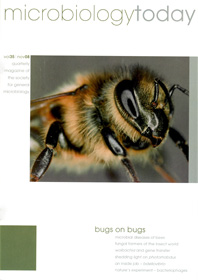Bugs On Bugs
01 November 2008 publication
The lead articles of the November 2008 issue of Microbiology Today are on microbial diseases of bees; fungal farmers of the insect world; wolbachia and gene transfer; shedding light on photorhabdus; an inside job - bdellovibrio; and nature's experiment - bacteriophages.
Microshorts (p. 166)
Lucy Goodchild takes a look at some stories that have hit the headlines recently.
Microbial diseases of bees (p. 168)
Bees play an essential role in the world's ecosystems, but as Travis Glare and Maureen O'Callaghan explain, microbial diseases are posing a big threat to these vital insects.
Ancient fungal farmers of the insect world (p. 172)
Leaf-cutter ants not only grow fungi to eat. Garret Suen and Cameron Currie reveal that they weed their 'gardens' and apply pesticides too.
Bacterial sequences in an invertebrate genome (p. 176)
Julie Dunning Hotopp and Jason Rasgon explain how some arthropods and nematodes need their bacterial inhabitants to survive.
Photorhabdus: shedding light on symbioses (p. 180)
Susan Joyce and David Clarke ask which amazing microbe can make nematodes glow in the dark and yet kill certain insects?
An inside job: Bdellovibrio bacteriovorus (p. 184)
These predatory bacteria hunt down and eat their fellow organisms, as revealed by Liz Sockett.
Bacteriophages: nature's most successful experiment (p. 188)
Graham Hatfull believes phages could well be the world's biggest reservoir of unidentified genetic material.
1983: a vintage year for pathogen discovery (p. 192)
Robin Weiss talks about how important findings about three major infectious diseases were made 25 years ago.
Schoolzone (p. 202)
Dariel Burdass describes some fascinating examples of predatory microbes, particularly focusing on some nematode-killing fungi.
Gradline (p. 206)
A new Concordat to support the career development of researchers was launched in June; Tristram Hooley and Tennie Videler from Vitae explain what it is and what it will mean in practice. Jane Westwell introduces three students who took part in the Microbiology Society Vacation Studentship scheme in 2007.
Obituary - Professor Chris Thurston (p. 210)
Robert Poole highlights the late Professor Chris Thurston's great accomplishments.
Going public (p. 215)
Lucy Goodchild explains how talking to the media is a good way of publicising research and informing people about microbiology.
Comment: Scotoma in contemporary microbiology (p. 220)
Are some bacteria really 'unculturable'? Probably not according to Howard Gest.
Cover image credit: Dr Jeremy Burgess/Science Photo Library

